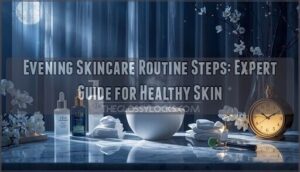This site is supported by our readers. We may earn a commission, at no cost to you, if you purchase through links.

Understanding how to properly cleanse oily skin breaks this pattern. The right technique removes excess sebum without stripping your skin’s natural barrier, which signals your glands to pump out less oil.
This dermatologist-backed approach transforms your cleansing routine from a temporary fix into lasting control.
Table Of Contents
Key Takeaways
- Cleansing oily skin twice daily with gentle, oil-free formulas prevents the rebound oil production that harsh scrubbing and overwashing trigger, allowing your sebaceous glands to self-regulate instead of compensating with excess sebum.
- Genetics account for up to 81% of oily skin traits, but environmental factors like heat (which increases sebum by 10% per degree Celsius), diet, stress, and sleep directly affect oil production and can be controlled through lifestyle adjustments.
- Noncomedogenic products with salicylic acid or niacinamide penetrate pores and regulate sebum without stripping your skin’s natural barrier, while ingredients like coconut oil, sodium lauryl sulfate, and petrolatum clog pores and worsen oiliness.
- Even oily skin requires lightweight, oil-free moisturizer to prevent your skin from overcompensating with more oil, and paradoxically, certain facial oils like jojoba can signal your glands to reduce sebum production by mimicking your skin’s natural composition.
What Causes Oily Skin?
Oily skin doesn’t happen by accident. Your sebaceous glands work overtime for specific reasons, from the genes you inherited to the stress you’re carrying.
Understanding what triggers excess oil production gives you the power to take control and make smarter choices for your skin.
Genetics and Hormonal Influences
Your genes and hormones shape how much oil your skin produces. Studies show genetics account for up to 81% of oily skin traits. If both parents had acne, your odds jump 2.6 times higher. Androgens like testosterone drive sebum regulation, peaking between ages 15–35.
Women notice hormone fluctuations during their cycle—oiliness spikes before menstruation. Ethnic variations also play a role, with specific genetic polymorphisms affecting sebaceous glands differently across populations.
Understanding the causes of oily skin, including skin oil production, is essential for effective skincare routines.
Environmental and Lifestyle Factors
Beyond your genetic blueprint and hormones, where you live and how you live matter. Temperature control and humidity effects directly affect oil production—sebum excretion jumps 10% per degree Celsius. Urban lifestyle exposure to air pollution triggers excess oil and clogged pores.
Your habits also count:
- Diet and skin health: High-sugar foods spike insulin, ramping up sebaceous glands
- Stress and skin: Cortisol from chronic stress fuels oiliness
- Sleep disruption: Late nights mess with your skin’s oil-water balance
- Screen time: Over 4 hours daily increases oil secretion
- Smoking and alcohol: Both alter sebum composition and worsen shine
Environmental factors and stress management shape your skin as much as your genes do. Understanding the impact of skin pollution effects is essential for maintaining healthy skin.
Identifying Your Skin Type
Before you can manage oily skin, you need to know what you’re working with—and a simple at-home test reveals your skin type in under an hour. Wash your face with a gentle cleanser, pat dry, and wait 30 minutes. Press blotting paper on your T-zone and cheeks. Visible oil indicates oily skin with overactive sebaceous glands. Clear paper suggests normal or dry skin.
For precise skin classification and pore analysis, consult a dermatologist who can assess your skin pH and genetic factors affecting your skin care routine.
How to Cleanse Oily Skin Step by Step
Cleansing oily skin isn’t about scrubbing harder or washing more often. The right approach combines targeted products with smart technique to control oil without triggering your skin to produce more.
Here’s how to build a cleansing routine that actually works.
Choosing The Right Cleanser
Your face wash should target oil without stripping your skin’s natural barrier. Look for gel-based formulas with salicylic acid or niacinamide—these cleanser ingredients penetrate pores and regulate sebum production. Check product labels for "oil-free" and "noncomedogenic" markers.
A mild cleanser maintains balance; harsh formulas trigger rebound oil production. Choose gentle formulas that foam lightly and rinse clean, leaving your skin refreshed but never tight.
Proper Cleansing Techniques
The technique you use matters just as much as the cleanser you choose—apply it wrong, and you’ll either miss the oil or irritate your skin into overproduction.
Use warm water to open pores, then massage your face wash in circular motions for 30-60 seconds. Gentle exfoliation during cleansing removes dead cells without triggering inflammation.
Rinse thoroughly—leftover product disrupts skin pH balance and clogs pores.
Ideal Cleansing Frequency
Twice daily cleansing—once in the morning and again before bed—strikes the ideal balance for oily skin without tipping into overdrive. Morning facial cleansing removes overnight oil buildup, while your nightly regimen clears away environmental debris and makeup.
Washing more frequently strips your skin’s pH balance, triggering your sebaceous glands to compensate with excess oil production. Stick to this daily cleansing schedule for effective oil control methods.
Common Cleansing Mistakes to Avoid
Even with the right cleanser, well-meaning mistakes can sabotage your efforts and leave your skin greasier than before. Watch out for these common pitfalls in skin cleansing:
- Overwashing strips natural oils, triggering rebound oil production
- Harsh products disrupt your skin’s protective barrier
- Inadequate rinsing leaves residue that clogs pores
- Excessive exfoliation irritates and inflames oily skin
Stick with a mild cleanser twice daily—your skin knows the difference.
Best Products for Oily Skin Care
Choosing the right products breaks the cycle of overactive oil glands and shine. Your cleanser sets the foundation, but toners, moisturizers, and sunscreens complete your defense against excess sebum.
Here’s what works and what to skip.
Oil-Free and Noncomedogenic Options
When you’re shopping for oily skin, think of noncomedogenic products as your safety net—they won’t clog your pores or trigger breakouts the way traditional formulas might. Look for labels that say "oil-free" or "mattifying"—these formulas keep shine under control without stripping your skin.
Even your moisturizer should be noncomedogenic and lightweight to balance hydration in your daily skincare routine.
Effective Exfoliators and Toners
Exfoliators and toners work like a one-two punch—scrubbing away dead skin cells and tightening pores so oil doesn’t build up where it shouldn’t.
Use salicylic acid weekly to exfoliate and clear blocked pores. Glycolic acid speeds up skin renewal without irritation.
A toner with pore minimizers helps cleanse your face after washing and creates that matte finish you’re after.
These products deliver real oil control when used consistently.
Moisturizers and Sunscreens for Oily Skin
You might skip moisturizer because your skin’s already slick—but that’s exactly when you need it most. Without proper skin hydration, your sebaceous glands overcompensate and pump out even more oil.
Skipping moisturizer on oily skin backfires—your glands overcompensate by producing even more oil
Choose a lightweight, oil-free moisturizer with gel-based formulas for enhanced oil control. Layer a noncomedogenic sunscreen daily to protect skin health without clogging pores or triggering breakouts.
Ingredients to Avoid
Most skincare products contain hidden troublemakers. Comedogenic oils like coconut oil and cocoa butter clog pores in up to 80% of oily skin users. Harsh surfactants—sodium lauryl sulfate strips natural oils and triggers rebound oiliness.
Occlusive agents such as petrolatum trap sebum beneath the surface. Synthetic fragrances irritate skin in 15% of cases. Preservative irritants disrupt your skin’s microbial balance and raise acne risk.
Daily Routine to Manage Oily Skin
Managing oily skin isn’t about a single magic product—it’s about building a consistent routine that works morning and night. Your daily regimen should address oil control without stripping your skin or triggering more sebum production.
Here’s how to structure your day-to-day approach for clear, balanced skin.
Morning and Night Skin Care Regimen
Consistency is the cornerstone of managing oily skin, and splitting your routine between morning and night gives your skin what it needs without overdoing it. In the morning, cleanse with a gentle pH-balanced cleanser, apply toner to tighten pores, then use an oil-free moisturizer with sunscreen.
At night, your dermatologist-approved skincare routine shifts focus: double cleanse to remove buildup, exfoliate weekly with salicylic acid, and finish with a lightweight moisturizer or targeted night mask.
Makeup Tips for Oily Skin
Oil-free makeup isn’t just a suggestion—it’s your first line of defense against midday shine and clogged pores. Look for noncomedogenic formulas with a matte finish that won’t trap sebum in your skin.
Start with an oil-control primer to create a barrier between your moisturizer and foundation. Use blush techniques that focus on powder over cream.
Always remove makeup thoroughly before bed.
The Role of Blotting Papers and Masks
Between washes, blotting papers work like instant oil erasers—press one against your T-zone and watch it lift shine without disturbing your makeup or irritating your skin.
Weekly clay masks pull excess sebum from deep within pores, offering powerful oil control that refreshes your complexion. These pore-minimizing treatments give your skin cleansing a boost when daily routines need backup.
Removing Makeup Properly
Leaving makeup on overnight is like locking oil, dirt, and bacteria into your pores—a recipe for clogged skin and breakouts that proper removal easily prevents.
Start your facial cleansing with an oil-free makeup remover to dissolve stubborn products. Follow with a gentle cleanser to complete the job.
Skip cleansing wipes—they spread residue instead of removing makeup before bed. Finish with pore minimizers or gentle toners for fresh, clean skin.
Lifestyle Changes for Lasting Results
Your skin care routine isn’t the whole story. What you eat, how you sleep, and how you manage stress all play a role in oil production. Here’s what to adjust beyond the bathroom sink.
Diet and Hydration Tips
What you eat directly impacts diet and skin health through several pathways. Glycemic control matters most—high-sugar foods spike insulin and trigger excess oil production. Here’s what works:
- Prioritize healthy fats and omega balance: Fish, flaxseed, and nuts reduce inflammation and regulate sebum output.
- Lower dietary factors that worsen oiliness: Cut refined carbs and dairy to decrease breakouts and shine.
- Boost water intake to 2 liters daily: Proper skin hydration improves texture without increasing oil control needs.
- Add vitamins A, C, D, and zinc: These micronutrients support skin lubrication balance and gland function through nutrient timing.
Managing Stress and Sleep
Chronic stress silently sabotages your skin by flooding your system with cortisol, which directly cranks up sebum production and worsens oiliness. Combat this through stress reduction practices like meditation and deep breathing.
Sleep quality matters too—aim for 7-8 hours nightly to reset cortisol levels and restore skin health.
Regular exercise impact extends beyond fitness, lowering stress while improving your skin care routine outcomes through better circulation and hormone balance.
When to Seek Professional Help
If your mirror still shows a greasy T-zone despite following every routine religiously, it’s time to call in a dermatologist who can dig deeper than over-the-counter products allow. Persistent skin breakouts, severe skin irritation, or worsening skin concerns warrant a dermatologist visit for proper skin analysis and medical treatment.
Professional skin care advice and dermatological care can uncover hormonal imbalances or underlying conditions that your bathroom cabinet can’t fix.
Frequently Asked Questions (FAQs)
Can oily skin benefit from facial oils?
Like adding fuel to a fire, the right facial oil can paradoxically calm oily skin. Certain oil types—including jojoba and squalane—mimic sebum composition, signaling your skin to reduce excess oil production.
They also enhance product penetration and moisturizer effectiveness without clogging pores.
How does weather affect oily skin cleansing?
Seasonal changes and humid climates trigger your sebaceous glands to work overtime.
Weather fluctuations mean adjusting your skin care routine—warmer temperatures and air pollution demand more frequent cleansing, while temperature control indoors can strip natural oils.
Should I use hot or cold water?
Warm water works best for oily skin cleansing—not hot or cold.
Hot water strips your skin’s natural barrier and triggers rebound oil production.
Cold water doesn’t dissolve sebum effectively, leaving residue behind.
Can over-cleansing make oily skin worse?
You can have too much of a good thing—overwashing strips your skin’s natural pH balance, triggering rebound oil production.
Stick to twice-daily skin cleansing with gentle formulas. Harsh treatments disrupt oil regulation and enlarge pores instead of minimizing them.
Do clay masks help control oil production?
Clay masks work. They absorb excess sebum and purify pores through natural mineral content.
Use oil control tips like applying a clay mask once or twice weekly—not daily—to avoid overdrying.
This facial care approach complements your skin cleansing routine for balanced sebum production.
Conclusion
A patient came to my clinic frustrated after years of over-cleansing made her skin greasier. Within three weeks of following a simplified routine—gentle cleanser twice daily, no harsh scrubbing—her oil production normalized.
Learning how to properly cleanse oily skin isn’t about stripping away every trace of sebum. It’s about respecting your skin’s biology. When you stop fighting your natural barrier and start working with it, your complexion responds by self-regulating. The shine you’ve battled for years finally fades, replaced by balanced, healthier skin that doesn’t need constant correction.
- https://www.symselect.com/oily_skin
- https://pmc.ncbi.nlm.nih.gov/articles/PMC2577631/
- https://www.cureus.com/articles/34874-epidemiology-of-acne-vulgaris-and-its-association-with-lifestyle-among-adolescents-and-young-adults-in-hail-kingdom-of-saudi-arabia-a-community-based-study.pdf
- https://www.nature.com/articles/s41598-024-85000-z
- https://pubmed.ncbi.nlm.nih.gov/17014635/










